
Many users aren’t really seeking for the very best standard zoom lens with its correspondingly high price tag. Instead they are looking for something that is “good enough”, versatile and doesn’t cost you an arm and a leg. “Super”-zoom lenses may appear to fulfill those needs but, to be honest, they are often not all that hot in terms of (consistent) quality. In order to close the gap, Panasonic just came up with an “in-betweener” – the Panasonic Lumix G 12-60mm f/3.5-5.6 ASPH Power OIS thus a still reasonable 5x zoom lens. It covers a field-of-view equivalent to about “24-120mm”. Or in other words it is one of those zoom lenses which may be nice to take in the lonely island scenario. It may not be exciting in terms of speed but the range covers most of the travel needs. Regarding a price tag of about 450US$/EUR, it also remains within reach of most mortals.
The Lumix lens may be quite small and light-weight (210g) but the build quality is really good. The body is made of a combination of metal and plastics parts based on a metal mount. The inner lens tube is made of plastic though. Zooming and focusing works smoothly. Interestingly Panasonic managed to implement some seals and they claim it to be splash/dust-proof. The lens extends when zooming towards the long end of the zoom range. The front element does not rotate making it possible to mount a petal-shaped lens hood (supplied). The lens features a higher-grade Power OIS (optical image stabilizer) which should give you an equivalent gain of 3ish f-stops. Unfortunately you have to fiddle around in the camera menu to (de-)activate it – there’s no dedicated switch for this on the lens itself. The OIS can be activated on Panasonic cameras only. On Olympus cameras you have to rely on the camera’s stabilizer (which works nicely anyway). On the latest Panasonic cameras you can take advantage of dual IS – thus the combined capabilities of in-lens and in-camera IS. This should give you a boost over the standard IS gain.

The AF is no surprise – it’s both fast and absolutely silent. Typical for a micro-four-thirds lens, manual focusing works “by wire” thus you trigger the AF motor by turning the focus ring.
| Specifications | |
|---|---|
| Equiv. focal length | “24-120mmmm” (full format equivalent) |
| Equiv. aperture | f/7-11.2 (full format equivalent in terms of depth-of-field) |
| Optical construction | 11 elements in 9 groups inc 3x aspherical and 1x ED element |
| Number of aperture blades | 7 (circular) |
| min. focus distance | 0.20m (1:3) |
| Dimensions (L x W) | 71x66mm |
| Weight | 210g |
| Filter size | 58mm |
| Hood | petal shaped, supplied |
| Other features | splash/dust-proof, image stabilizer |
Distortion
The Micro-Four-Third system uses an automatic distortion-correction thus from a user perspective, there is little to worry about. Images only show a moderate degree of barrel distortion (1.6%) a 12mm and there is not much to report about beyond.




While most RAW converter as well as the camera (JPEGs) don’t give you a choice, a few still do (e.g Capture One) thus it is possible to verify the original characteristic of the lens. With disabled auto-correction, the Panasonic lens shows a barrel distortion of no less than 6.5% at 12mm. This is, once more, nothing short of excessive really and a sign that the lens was purposely under-designed to save costs and/or reduce the size/weight. Such a level of distortion correction has also a negative impact on the border resolution at 12mm because it results in rather heavy image interpolation. The 25mm setting is much better with a moderate degree of the pincushion distortion. 40mm and 60mm are fairly well corrected.
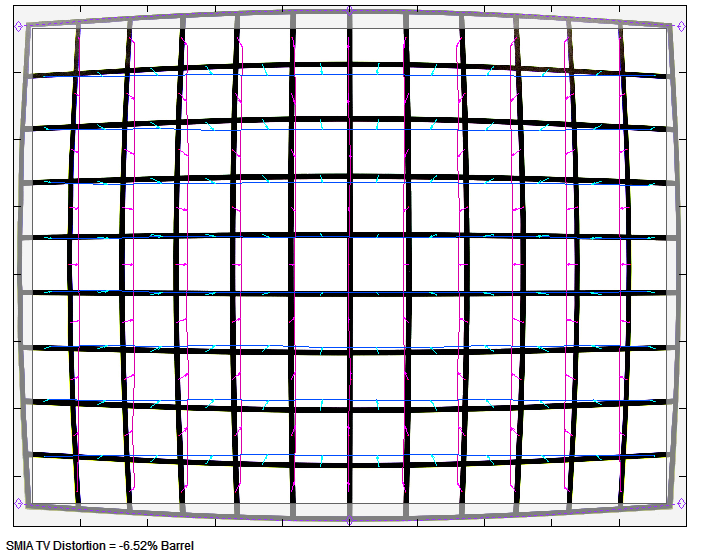
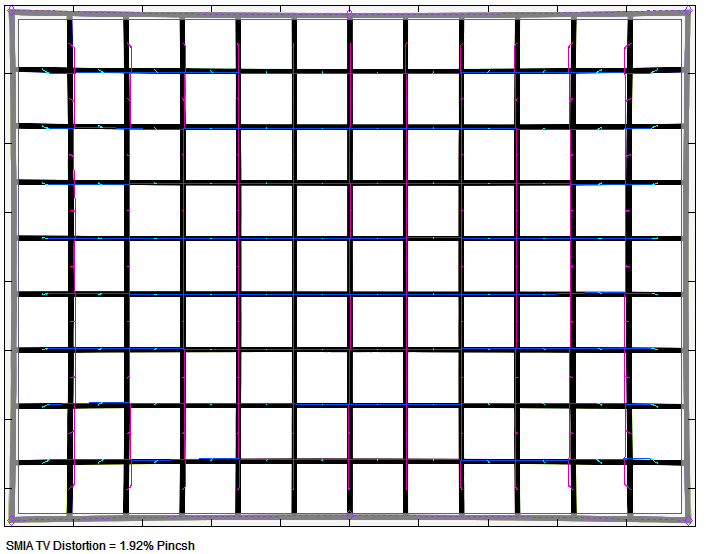
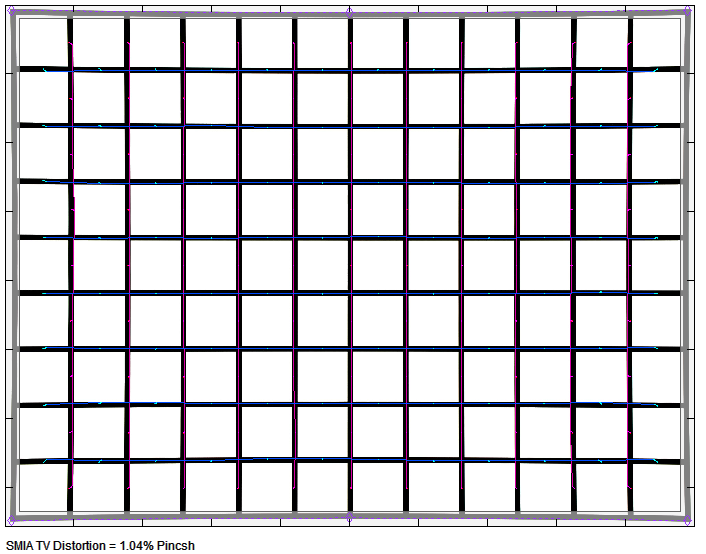
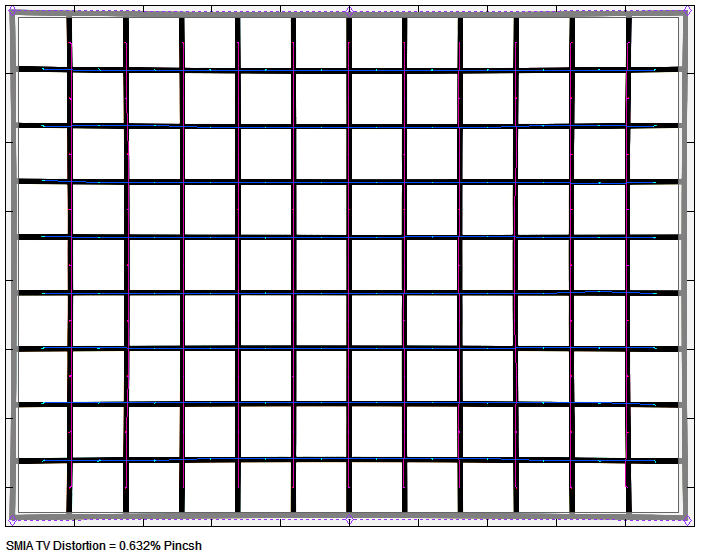
Vignetting
Auto-correction is also applied to the vignetting characteristic. The system produces a medium light falloff of around 0.7 EV (f-stops) at 12mm f/3.5. Stopping down reduces the issue slightly. It’s not a big deal beyond the 12mm setting.
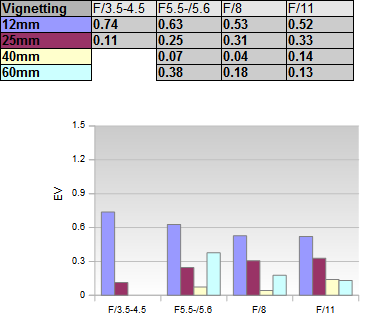
The situation changes again when looking at the original data (without distortion- nor vignetting- correction). Unsurprisingly 12mm f/3.5 remains the weak spot with a peak vignetting of 2.4EV (f-stop). cough Stopping down to f/5.6 resolves some of the issue but f/8 is needed to tame it to a reasonable degree. The other settings aren’t overly affected again but it still helps to stop down a little.
Some users are wondering why we are exploring the uncorrected behavior in the first place. Please note that vignetting compensation is NOT lossless. Correcting light-falloff increase the amount of noise due to the required image amplification.
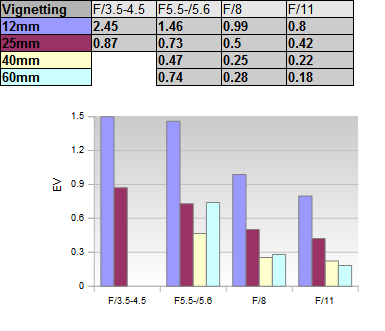
MTF (resolution)
The Panasonic Lumix G 12-60mm f/3.5-5.6 ASPH Power OIS managed to deliver a decent albeit generally unexciting resolution. It is slow lens thus the center peak performance is already available at full open aperture (due to diffraction). The center is excellent at 12mm f/3.5 and remains very high till f/8. The outer image region is generally good to very good. The center quality decreases slowly the more you zoom out to 60mm whereas the border/corner quality remains on a good to very good level. Diffraction effects start to have a higher impact beyond f/11. Remember that f/11 is equivalent to “f/22” on full format cameras so it’s obvious that you don’t really need to stop down that much on micro-four-thirds most of the time anyway.
We tested TWO samples. Both performed fine in the lab but they both showed a centering issue at 60mm in real life images (lower left) which was a little puzzling actually. Usually you can spot such issues during the lab tests already. It may be that the IS group isn’t properly locked (which is not relevant on a studio tripod) but this is speculative.
Please note that the MTF results are not directly comparable across the different systems!
Below is a simplified summary of the formal findings. The chart shows line widths per picture height (LW/PH) which can be taken as a measure for sharpness. If you want to know more about the MTF50 figures you may check out the corresponding Imatest Explanations

Chromatic Aberrations (CAs)
Lateral CAs (color shadows at harsh contrast transitions) are present but remain below 1px on the average at the image borders. As such they aren’t really disturbing.

Sample Images
The Panasonic Lumix G 12-60mm f/3.5-5.6 ASPH Power OIS is a jack of (almost) all trades but a master of none. So from a user perspective it doesn't really have pronounced weaknesses but it doesn't excite either. The center resolution is great at 12mm and the borders/corners are quite decent for standard zoom lens. The results soften towards the 60mm but remain easily usable. Panasonic uses auto-correction to hide some optical weaknesses thus distortions and vignetting are well controlled unless you leave the sandbox. An original distortion of 6.5% at 12mm is a bit over the top in our book just to mention again. Lateral CAs are no issue.
The build quality of the Panasonic lens is pretty good. Rather than just using a plastics, Panasonic used a metal/plastic combination for the body based on a metal mount. The inner lens tube doesn't wobble even when fully extended to 60mm. The weather sealing is certainly a very welcome feature as well. Most modern Panasonic lenses provide a high speed AF and this also applies to this one. AF operations are also silent (and accurate anyway). The Power OIS (image stabilizer) is efficient albeit a little inferior to -say- Canon or Nikon. However, at least Panasonic GX8/85/80 users can take advantage of dual IS (body+lens IS).
The question remains where this leaves us in the grand scheme of things. In terms of quality the lens doesn't really offer anything over the basic kit lenses and not too much over the more extreme 14-140mm zoom lenses in the overlapping range. To be fair - the Panasonic lens shares this characterization with many similar lenses (in different systems) but as such it's also a missed opportunity once again. So it's a good lens but nothing special either.
-
Optical Quality
-
Build Quality
-
Price / Performance

